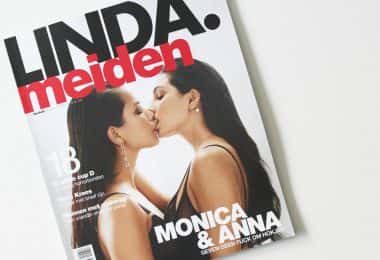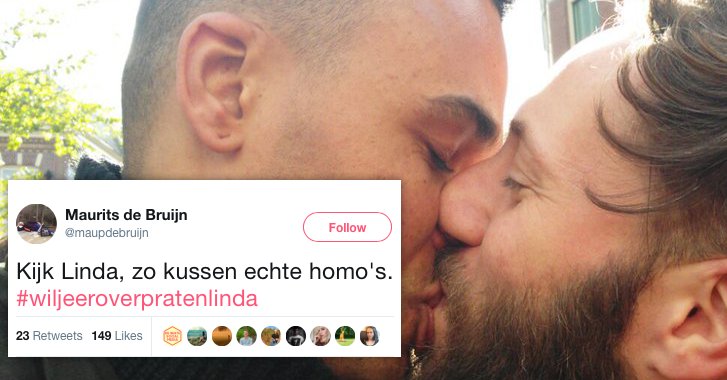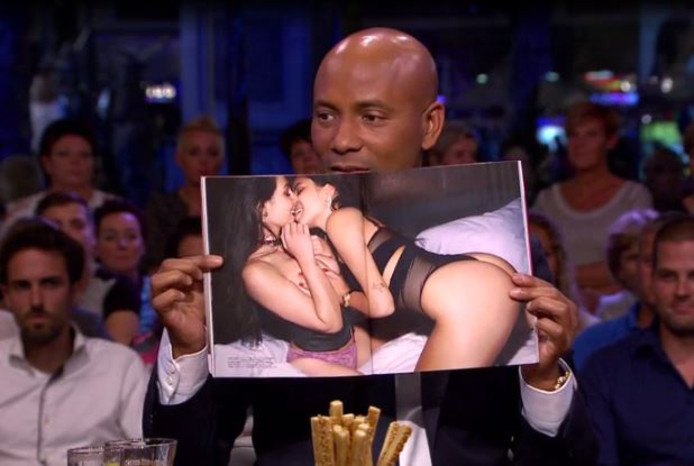
‘Oh my god, are they really kissing?!’ my roommate was pointing at her phone whilst excitingly dangling the image in front of my eyes. I recognized two famous Dutch vloggers, Monica Geuze and Anna Nooshin, who were intimately posing on the cover of the magazine LINDA.meiden (a magazine for teenage girls). Only a few minutes later, my roommate and I had found a behind-the-scenes video where the, for the record straight, young women explain why they wanted to be photographed in this specific pose. Their argument was bluntly articulated in a caption on the cover too: ‘Monica en Anna geven geen fuck om hokjes’, which can be translated as: ‘Monica and Anna do not give a fuck about labels’.
In their attempt of ‘doing the good thing’, by teaching equality to young teenage girls as well as all the other readers of LINDA.meiden, they somehow received loads of critique. Mainly out of the gay-community in the Netherlands. The same day that the issue of LINDA.meiden appeared in stores, a new Twitter hashtag gained popularity: #wiljeeroverpratenlinda (which can be translated as #doyouwanttotalkaboutitlinda). The overall argument against the two vloggers was:
‘Once again, the heterosexuals fake to be ‘oh so free’ in their sexuality whilst when there are, on the opposite, very few lesbian- or bisexual couples on the cover of LINDA, that hurts (VICE 09/06/2017)’.
Through reading the article Gender in and beyond the Canon, or how to make Women (In)visible in History by the gender historian Geertje Mak, all the commotion caused by the image and the message of the two Dutch vloggers, started to make sense to me.
In the recent years, Mak states, there is a historical trend of making the emancipation of women and homosexuals into the cornerstone of Dutch culture as a final capstone of the Enlightenment progress in the Netherlands. At the same time, the need for a national historical canon, with equality and tolerance as outcome, arose. According to Mak:
‘The main problem is what such a story leaves out. Political history – in particular, legislation – and the history of ideas are the chief domains in which progress is described. At the same time, several other possible measures for progress are reduced to footnotes to the master narrative (Mak 2007: 131).’
Within the canon, very less attention or even none at all, is given to the role of unequal gender relations and sexuality, since the history that is being referred to in the canon is focused on the domains from which minorities have traditionally been excluded (those of politics and ideas). Therefore, when the two vloggers are taking up the narratives about tolerance and anti-labeling, they are actually reinforcing and obscuring those very gender asymmetries on which they are based.
This may sound difficult, but I will now exemplify how those gender asymmetries appear in the story of Monica and Anna. First, there is the so called ‘problem of progress’ according to Mak. The discourse on equality that emerged from the Enlightenment and onwards, with social inclusion as a goal, causes exclusion at the same time. By trying to teach other people about equality, there is the danger of objectifying the minority.
When two heterosexuals pose as allegedly homo- or bisexuals, they objectify the real minority and exclude them. Even though it is the opposite of their goal, they endorse the asymmetrical gender relations in society.

Furthermore, there is the problem of the normalization of the woman’s’ body. As Mak explains in her article, often only the success stories about the emancipation of women and homosexuals are told.
‘Framed in an epic story of the advance of equality, it does not take into account how new standards for equality create novel discourses of inequality (Mak 2007: 138)’.
A few days after the issue of the LINDA.meiden was published, the two vloggers were invited at a Dutch talk show. In the show, they were asked to explain their actions with regards to the magazine.

The male host asked another guest at the table what his opinion about the cover was. The male guest started laughing and sarcastically said: ‘Well yeah, what do you want, do you think I’m the only one who will say “I don’t like it at all”. Through this example, one can see that the bodies of the two women are, even aside from the argument they try to make, normalized and sexualized referred to the heterosexual standard.
One question remains, if the anti-labeling campaign was not received well, what should have been the right way for Monica and Anna to address their viewpoint?
By: Anne-Goaitske